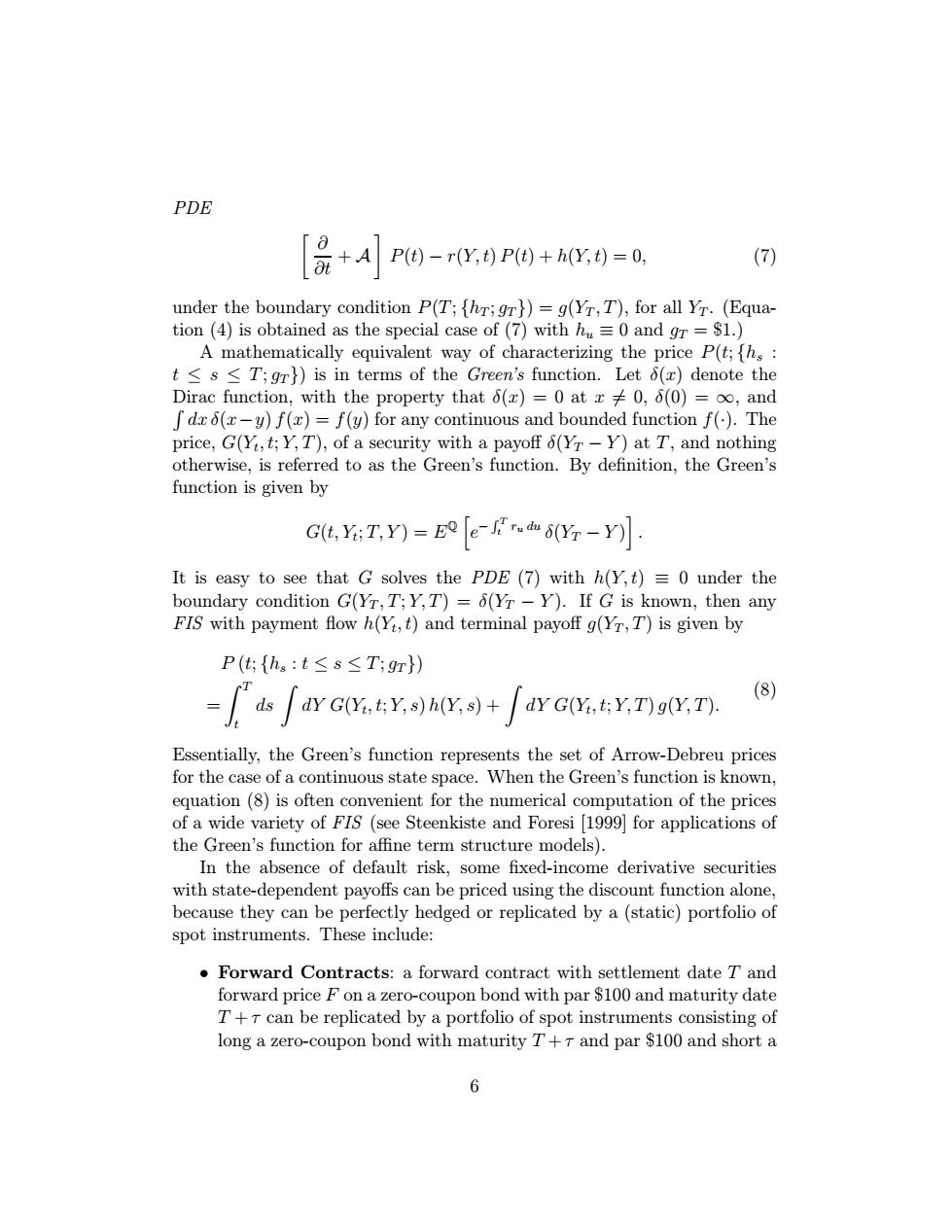正在加载图片...

PDE +A P(t)-r(Y,t)P(t)+h(Y,t)=0, (7) under the boundary condition P(T;[hr;gr})=g(Yr,T),for all Yr.(Equa- tion (4)is obtained as the special case of (7)with hu=0 and gr=$1.) A mathematically equivalent way of characterizing the price P(t;ths t<s<T;gr})is in terms of the Green's function.Let 6(x)denote the Dirac function,with the property that 6(x)=0 at x0,6(0)=oo,and fdr6(x-y)f(x)=f(y)for any continuous and bounded function f().The price,G(Yi,t;Y,T),of a security with a payoff (Yr-Y)at T,and nothing otherwise,is referred to as the Green's function.By definition,the Green's function is given by G(t,YiT,Y)=E er(Yr-Y). It is easy to see that G solves the PDE (7)with h(Y,t)=0 under the boundary condition G(Yr,T;Y,T)=6(Yr-Y).If G is known,then any FIS with payment flow h(Yi,t)and terminal payoff g(Yr,T)is given by P(t:{hs:t≤s≤T;gr}) -ds dr G,tys)hny到+& (8) dYG(Yi,t;Y,T)g(Y,T). Essentially,the Green's function represents the set of Arrow-Debreu prices for the case of a continuous state space.When the Green's function is known, equation (8)is often convenient for the numerical computation of the prices of a wide variety of FIS (see Steenkiste and Foresi [1999]for applications of the Green's function for affine term structure models). In the absence of default risk,some fixed-income derivative securities with state-dependent payoffs can be priced using the discount function alone, because they can be perfectly hedged or replicated by a(static)portfolio of spot instruments.These include: Forward Contracts:a forward contract with settlement date T and forward price F on a zero-coupon bond with par $100 and maturity date T+r can be replicated by a portfolio of spot instruments consisting of long a zero-coupon bond with maturity T+r and par $100 and short a 6PDE ∂ ∂t + A P(t) − r(Y, t) P(t) + h(Y, t)=0, (7) under the boundary condition P(T; {hT ; gT }) = g(YT , T), for all YT . (Equation (4) is obtained as the special case of (7) with hu ≡ 0 and gT = $1.) A mathematically equivalent way of characterizing the price P(t; {hs : t ≤ s ≤ T; gT }) is in terms of the Green’s function. Let δ(x) denote the Dirac function, with the property that δ(x) = 0 at x 6= 0, δ(0) = ∞, and R dx δ(x−y) f(x) = f(y) for any continuous and bounded function f(·). The price, G(Yt, t; Y, T), of a security with a payoff δ(YT − Y ) at T, and nothing otherwise, is referred to as the Green’s function. By definition, the Green’s function is given by G(t, Yt; T,Y ) = EQ h e− R T t ru du δ(YT − Y ) i . It is easy to see that G solves the PDE (7) with h(Y, t) ≡ 0 under the boundary condition G(YT , T; Y, T) = δ(YT − Y ). If G is known, then any FIS with payment flow h(Yt, t) and terminal payoff g(YT , T) is given by P (t; {hs : t ≤ s ≤ T; gT }) = Z T t ds Z dY G(Yt, t; Y, s) h(Y, s) + Z dY G(Yt, t; Y, T) g(Y, T). (8) Essentially, the Green’s function represents the set of Arrow-Debreu prices for the case of a continuous state space. When the Green’s function is known, equation (8) is often convenient for the numerical computation of the prices of a wide variety of FIS (see Steenkiste and Foresi [1999] for applications of the Green’s function for affine term structure models). In the absence of default risk, some fixed-income derivative securities with state-dependent payoffs can be priced using the discount function alone, because they can be perfectly hedged or replicated by a (static) portfolio of spot instruments. These include: • Forward Contracts: a forward contract with settlement date T and forward price F on a zero-coupon bond with par $100 and maturity date T + τ can be replicated by a portfolio of spot instruments consisting of long a zero-coupon bond with maturity T +τ and par $100 and short a 6